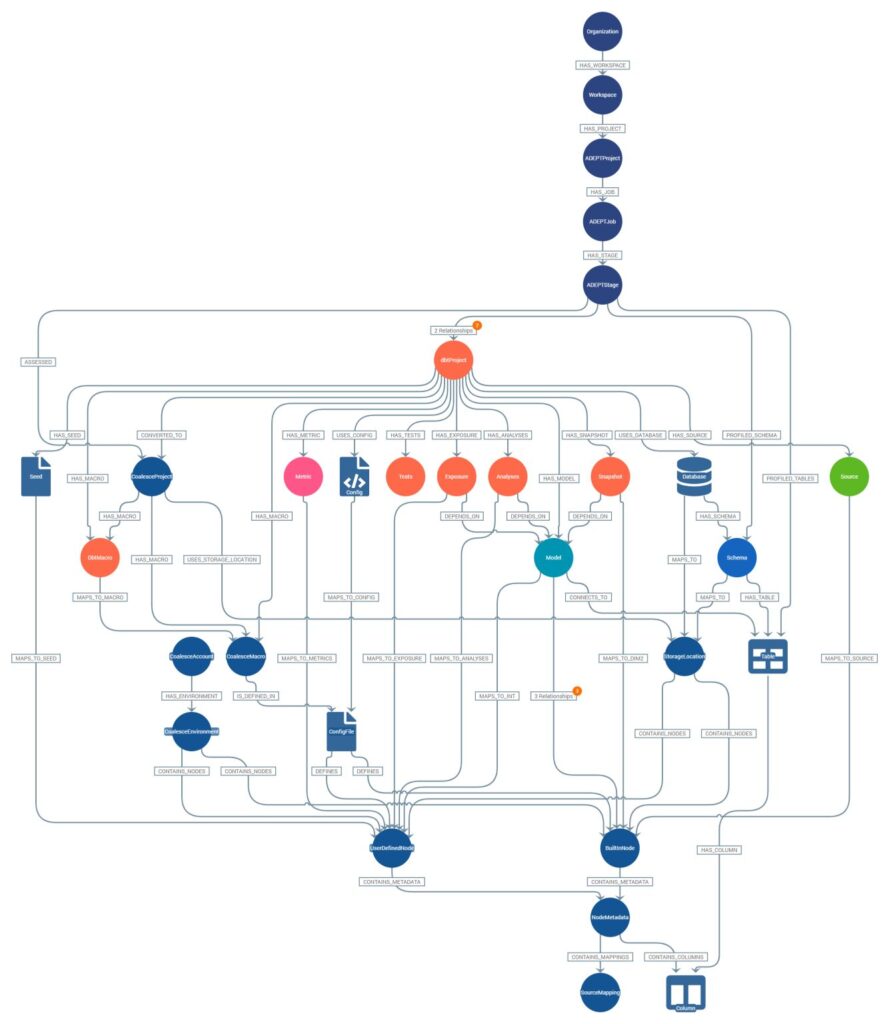Introduction
Just as we once swapped outdated cassette tapes for versatile digital platforms, the transition to modern data management strategies is equally essential for businesses. With ever-evolving technology and landscapes, a failure to adapt might just mean scoring an own goal in the digital soccer field.
A messy data management strategy can stifle your business prospects by keeping you stuck in the past. The weight of overflowing data, disorganized databases, and imprecise insights can be as burdensome as sifting through stacks of crumpled papers in the hunt for a single document on a desk. Do you still depend on traditional, monolithic data systems in the era of cloud technology and AI-driven analytics? Does your business suffer from data’s equivalent of a cluttered and disorganized desk? You might just need a more modern system.
Welcome to the ‘spring cleaning’ of data management; a chance to declutter, streamline, and update. We will dive into the signs of an obsolete data strategy and how to rejuvenate it for the digital age. An efficient, sleek and updated system isn’t a distant reality; so brush off that antiquated dust, for a future that promises agile responses, better insights, and optimal growth—a future where comprehensive data management is becomes an integral business tool.

Recognizing the Signs of an Outdated Data Management Strategy
- Identify poor data governance and its effects on your business.
- Understand how low-quality data impacts decision-making.
- Recognize the pitfalls of data silos and lack of integration.
Inefficient Data Governance: The Impact on Your Business
The effectiveness of your data management strategy can often be gauged by assessing your data governance. Inefficient data governance can manifest in numerous ways, the most detrimental being inconsistent data availability, lack of adherence to privacy laws or standards, or insufficient data protection measures.
Strong data governance ensures data is consistently and reliably available for your business. Conversely, poor data governance often results in patchy data access across departments, reducing efficiency and potentially causing friction in your business processes.
Laws and regulations surrounding data have become increasingly stringent. A clear sign of outdated data governance is lax adherence to these fundamental standards, risking severe legal and financial repercussions. With rising concern for data privacy, businesses with poor data governance may suffer reputational damage among consumers.
Data protection is another crucial facet of data governance. An outdated strategy may lack the necessary measures to safeguard against data breaches, opening your business up to further legal complications and customer distrust.
Poor Data Quality: How it Affects Your Decision-Making Process
Effectively functioning data is the lifeblood of any business decision. Therefore, maintaining high data quality becomes cardinal in modern business operations. But, an outdated data management strategy may nurture poor data quality, thus affecting your decision-making process.
Understanding low-quality data is simple. It’s inaccurate, inconsistent, incomplete or redundant. This kind of data causes flawed insights and unreliable forecasts, leading to misguided decisions and strategies.
It’s not only about decision-making, low-quality data can also lead to inefficiencies, wasted resources, and the potential for reputational damage if incorrect information is publicly available or used in customer interactions.
Lack of Data Integration: The Problem with Data Silos and Lack of Integration
Outdated data management strategies often generate data silos. These are isolated islands of data held by one department, inaccessible to others. Data silos not only obstruct a unified view of business insights but also curtail cross-functional collaborations, ultimately hammering business innovation and growth.
Lack of data integration across departments aggravates the problem of data silos. When your systems don’t communicate with each other, you risk duplicating, overlooking, or misinterpreting essential data.
This lack of integration also contributes to inefficiencies – with departments redoing work or taking longer to complete tasks due to inaccessible information. Shifting towards a data management strategy that encourages integration reduces these inefficiencies and fosters better collaboration, ultimately promoting a better understanding of your business as a whole.
The Consequences of Sticking with an Outdated Data Management Strategy
- High risk of data breaches
- Skewed business insights affecting decision-making
- Potential legal issues due to non-compliance with regulations
Increased Security Risks: How outdated data management can expose your business to data breaches
Outdated data management systems provide a playground for cybercriminals. They expose businesses to data breaches, one of the worst nightmares for any organization. Technology evolves fast, and so do hacking strategies. Outdated systems usually cannot keep up with these advancements, leaving them vulnerable.
Leaving the doors open to cyber attacks
Obsolete data management strategies often have weak security protocols. Cybersecurity threats are evolving rapidly, and data management strategies should evolve in lockstep. Systems that aren’t regularly updated can provide easy access points for hackers, putting your valuable company data at risk.
The cost implications of a data breach
Data breaches aren’t just about stolen information but also lead to massive financial losses. According to a study by the Ponemon Institute, the average cost of a data breach in 2020 was $3.86 million. But it’s not just the direct financial loss. Companies also face reputational damage that has long-lasting impacts on business performance.
Inaccurate Business Insights: The effect of poor data management on business intelligence and decision-making.
Data is the new fuel powering businesses. It provides valuable insights that guide strategic decisions. However, outdated data management strategies risk providing inaccurate information—leading to poor decisions that can affect a company’s bottom line.
Suffering from data inaccuracy
As it stands, outdated data management systems can lack essential data quality measures, such as data validation and cleansing. Without these features, you could be making critical decisions based on invalid, incomplete or incorrect data.
The effect of subpar analytics
Poorly managed data can affect your analytics output. To gain accurate insights and make data-driven decisions, your data needs to be managed appropriately. Older systems often lack integration, making it difficult to merge and analyze data from different sources, thus affecting the overall analytical output.
Regulatory Compliance Issues: The potential legal implications of outdated data management practices.
One of the most debilitating effects of outdated data management is the risk of non-compliance with modern data regulations. Laws such as GDPR, CCPA, and others, mandate stringent data handling practices with heavy penalties for non-compliance.
Falling foul of modern regulations
Outdated systems may not have been designed with today’s data privacy standards in mind. They could lack effective measures for consent management, data anonymization, or cybersecurity. Non-compliance with regulations can result in hefty fines, not to mention damage to customer trust and company reputation.
Legal implications weighing you down
Managing legal implications of non-compliance is daunting and distracting. You could find yourself spending more time managing legal issues related to data mismanagement rather than focusing on business growth.
While recognizing these dangers is crucial, it’s just one part of the puzzle. Your organization must take active measures to modernize your data management strategy. Being aware is the first step, taking action comes next.

Modernizing Your Data Management Strategy: Key Considerations
- High risk of data breaches
- Skewed business insights affecting decision-making
- Potential legal issues due to non-compliance with regulations
Embracing Data Governance: The role of data governance in a modern data management strategy.
Data governance isn’t just checkbox compliance anymore. Rather, it’s becoming the core of any modern data management strategy. Implementing formal data governance ensures uniform data management rules and practices across the organization, leading to reliable and consistent data.
In an age where data breaches are worryingly common, organizations need to be confident about who has access to what data and when. Effective data governance tools and practices can manage privacy, security, and compliance risks while maximizing data’s value. Remember, unmanaged data can lead to significant risks and lost opportunities.
Prioritizing Data Quality: The importance of data quality and how to improve it.
High-quality data is critical. From customer segmentation to predictive analytics, it’s only high-quality data that leads to sound decisions and strategies. If the data is outdated or incorrect, decisions made on the basis of that data will likewise be flawed.
Improving data quality often involves a multidimensional approach, including accuracy, completeness, consistency, and timeliness. Businesses can adopt various methods to enhance data quality, such as data cleaning, validation, and monitoring.
1 in 4 companies cite poor quality data as a barrier to successfully implementing business intelligence. So, improving your data quality is no longer optional.
Implementing Data Integration: The benefits of integrating your data sources and how to do it.
Data integration is the process of combining data from different sources to provide a unified, more complete view of customers, operations, and markets. It’s a cornerstone of modern data management, enabling businesses to link disparate databases, remove data silos, and adapt to new data challenges quickly.
Companies reporting successful data integration see major business benefits, from improved real-time decision making (1 in 3 companies) to increased operational efficiency (1 in 4 companies). Implementing it effectively requires a strong foundation, right technology choices, and close alignment with business objectives.
Remember, the benefits of modernizing your data management strategy go beyond just improving operations. It’s about unleashing the full potential of your data-driven insights, fueling innovation, and gaining a competitive edge in today’s demanding business environment.
Securing Your Data: A Crucial Aspect of Modern Data Management
- Understanding the importance of data security and its implications on your business.
- Outlining the best practices to ensure that your data is secured.
- Grasping the need for continual data security updates to keep up with evolving threats.
Understanding Data Security: What it means and why it’s important.
As a pivot from our previous exploration of modernizing your data management strategy, let’s delve into an essential aspect – data security. Essentially, data security refers to measures or techniques used to protect digital data from unauthorized access, corruption, or theft.
It’s the backbone of any data-driven decision and strategy, safeguarding the integrity and privacy of your data. In today’s data-saturated world, securing your data isn’t an option but a necessity. Organizations that overlook the phase of data security expose themselves to risks such as data breaches, loss of client trust, and potential non-compliance fines. With the surge in cybercrime and more stringent data protection regulations, understanding and employing robust data security measures has never been more important.
Data security isn’t just about prevailing against external threats, either. It also involves safeguarding your data from insider threats and potential accidents caused by your own employees. As part of a modern data management strategy, adequate measures must address these internal threats and manage the risks related to people, processes and technology.
Best Practices for Data Security: Practical steps to secure your data.
The first phase towards securing your data is knowing the critical practices that can be implemented immediately. Here are some helpful starting points:
Regular Data Backup and Recovery Plan
Consistent data backups (both on-site and off-site) are vital for protecting your data from accidental losses. Coupled with a practiced recovery plan, it ensures business continuity in the wake of a disaster situation.
Use of Encryption and Access Controls
Proper encryption methods secure your data from unauthorized access, while tight access controls make sure only the right personnel can access sensitive data. Consider employing Multi-Factor Authentication (MFA) for an additional layer of security.
Regular Security Audits and Vulnerability Assessments
Regularly conducting security audits and vulnerability assessments can help identify and fix potential weaknesses in your data security strategy.
While the steps highlighted above provide a robust foundation, it’s important to note that data security isn’t a one-time task but a continuous responsibility. It requires regular updates aligning with evolving threats and technological advancements. A dynamic, evolving approach to data security is a cardinal point of modern data management strategy that cannot be ignored.
Remember, while we strive for an all-encompassing data security strategy, there will always be potential trade-offs – between access and control, security and usability, and cost and potential risk. However, with a deep understanding and layered approach to data security practices, you can pretty much hit the sweet spot in securing your data.
The Role of Data Lifecycle Management in Modern Data Management
- Data lifecycle management paints a clear picture of data flow process
- A roadmap to more effective and efficient Data Management Strategy
- Key to detecting and rectifying outdated Data Management practices
Understanding Data Lifecycle Management: What it is and why it matters.
Data Lifecycle Management (DLM) seems like a complex term, but it’s all about understanding how your data moves in your system. In its simplest form, DLM is a policy-driven approach that manages data flow from creation to deletion.
It’s integral to data-driven companies and plays a pivotal role in aligning business objectives with data management strategy. With a complete and correct understanding of DLM, businesses can attain seamless data flow, optimized storage use, and effective data security.
Managing the journey of your data is of utmost importance. Imagine your data as employees: starting from induction (creation), progressing to different roles (utilization), and then retirement (deletion). A proper understanding and execution of such progression allow us to squeeze maximum value out of our data.
Implementing Data Lifecycle Management: Steps to effectively manage your data throughout its lifecycle.
Now that we understand DLM, let’s see how we can put it into action. Comprehensive Data Lifecycle Management entails five core stages: creation, processing and utilization, storage and maintenance, archival, and eventual deletion.
Creation marks the genesis of data, when a customer logs in or when an internal report is run. Processing and utilization involves putting the data into action, such as analysis or business decisions. Next, the data is stored and maintained in databases ensuring its security and integrity over time.
The archival stage involves moving less frequently accessed data to cheaper and slower storage devices. Finally, data that exceeds its retention period or no longer serves its purpose is carefully deleted.
Implementing proper DLM reduces risks, optimizes data accuracy, improves efficiency, and ultimately drives more informed business decisions. It’s not just about storing your data properly, it’s about asking the right questions. How long should data be retained? Where is it stored? Is it secure? Can it be accessed quickly for analysis?
With a solid DLM strategy, you can answer these questions confidently, ensuring your business operates like a well-oiled machine fueled by accurate and timely data.
Interactive Checklist: Assess Your Data Management Strategy
Evaluate your current data management strategy by checking off the items that apply to your organization. This interactive checklist will help you identify areas for improvement and align your practices with modern best practices.
Data Governance
- We have a clear data governance policy that is communicated across the organization.
- Our data governance policy includes roles and responsibilities for data management.
- We regularly review and update our data governance policies to comply with current regulations.
Data Quality
- We have processes in place for data cleaning and validation.
- Our organization utilizes tools or software for maintaining high data quality.
- Data quality metrics are regularly reviewed to ensure accuracy and consistency of data.
Data Integration
- Our data systems are integrated, allowing for seamless data sharing across departments.
- We use a centralized data storage solution to minimize data silos.
- Data integration is considered in the planning phase of new IT projects.
Security and Compliance
- Data security measures (encryption, access controls, etc.) are implemented and regularly updated.
- We conduct periodic security audits and vulnerability assessments.
- Our data management practices are in compliance with relevant data protection regulations (e.g., GDPR, CCPA).
Data Lifecycle Management
- We have a defined data lifecycle management (DLM) policy that includes creation, storage, use, archiving, and deletion.
- DLM policies are applied across all data, regardless of format or location.
- Employees are trained on the importance of DLM and their role in it.
Modern Data Management Technologies
- We leverage cloud technologies for flexible, scalable data storage and processing.
- AI and machine learning are utilized for data analysis and insight generation.
- We continuously explore and adopt new technologies to enhance our data management capabilities.
Scoring
- 0-5 Checked Boxes: Your data management strategy may be significantly outdated. Consider immediate action to modernize your approach.
- 6-10 Checked Boxes: You’re on the right path but still have areas to improve. Focus on the unchecked items to further modernize your strategy.
- 11-15 Checked Boxes: Your data management strategy aligns well with modern practices. Continue to innovate and stay updated with emerging technologies.
Next Steps
Based on your score, consider the following actions to improve your data management strategy:
- Review unchecked items for opportunities to modernize and improve.
- Seek professional consultation for areas outside your expertise.
- Plan a roadmap for integrating modern data management practices into your strategy
Revisit and Revamp: Time to Modernize Your Data Management Strategy
The digital age waits for no one. Outdated data management strategies pose significant risk to business operations and profitability, and can be a hindrance to gaining a competitive edge.
Updating your strategy aligns with the current wave of technological advancements and leverages the sprawling, rich landscape of data insights. It’s essential to ensure efficiency, risk management, and apt responsiveness in today’s world.
The best time to revamp was yesterday, the next best time is now. Keep up with the pace, for an outdated system could just be the dam blocking your success flow.



